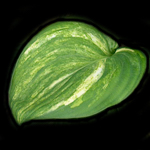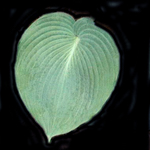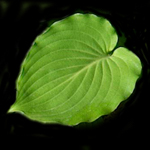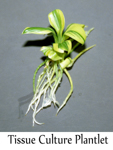|
 In the spring and summer of 2022, we launched a very tedious, time
consuming, eye straining but rewarding project to identify the
genetic lineage of many thousands of cultivars in our database. As
with anything related to hostas, most of the process was very
straight forward while a few aspects were complicated and tricky. In the spring and summer of 2022, we launched a very tedious, time
consuming, eye straining but rewarding project to identify the
genetic lineage of many thousands of cultivars in our database. As
with anything related to hostas, most of the process was very
straight forward while a few aspects were complicated and tricky.
We looked at our data and found that around 400 plants were involved
in the creation of 3 or more new hostas each which accounted for
several thousand named cultivars. There were over 1,000 more hostas
that were involved in the creation of only 1 or 2 new cultivars. It
soon became apparent that dealing with the second group would have
to wait. The time involved in going through thousands of database
records one at a time and creating new results pages needed to be
spread out.
Major emphasis was placed on highly productive plants such as 'Sieboldiana',
'Fortunei', 'Dorothy Benedict', Hosta montana, 'Frances
Williams', 'Elegans', 'Tokudama' and a few hundred others that
are in the genetic background of the vase majority of hosta
cultivars in the world today.
 For each of the plants in the 400, we went back into their ancestry
until we reached a species or an "Unknown" parent deadend. For
example, all hostas such as 'Halcyon' included in the famous
Tardiana Group and all of their descendants have 'Tardiflora',
Hosta longipes lancea, Hosta longipes, 'Elegans', 'Fortunei',
'Tokudama' and 'Sieboldiana' in their background. For each of the plants in the 400, we went back into their ancestry
until we reached a species or an "Unknown" parent deadend. For
example, all hostas such as 'Halcyon' included in the famous
Tardiana Group and all of their descendants have 'Tardiflora',
Hosta longipes lancea, Hosta longipes, 'Elegans', 'Fortunei',
'Tokudama' and 'Sieboldiana' in their background.
-
'Tardiflora' is a
seedling of Hosta longipes lancea which is a
sport of the species Hosta longipes.
-
'Elegans' is,
according to
The Hostapedia, a hybrid of 'Sieboldiana'
and either 'Fluctuans' or 'Tokudama'.
So, we needed to enter these 5 cultivars and species into each
record of related plants so that a search would bring all of the
plants with, say, 'Sieboldiana' in their background into one list.
In the case of 'Sieboldiana' which may have a thousand of related
plants (and others with 100 or more), we also divided the results
into 24 alphabetical pages by first name of the related cultivar.
Resolving Conflicts and Confusion -
In some cases, there is either confusion or contradiction in
what is reported as the parentage of a cultivar. Sometimes the
parent is incorrectly recorded
 As noted above, one primary example is 'Elegans' which is in the
genetic background of over a thousand cultivars. According to The
Hostapedia, it is a hybrid of 'Sieboldiana' and either 'Fluctuans'
or 'Tokudama' while most people think it is a sport of the former
species Hosta sieboldiana which was changed to a cultivar, 'Sieboldiana'. As noted above, one primary example is 'Elegans' which is in the
genetic background of over a thousand cultivars. According to The
Hostapedia, it is a hybrid of 'Sieboldiana' and either 'Fluctuans'
or 'Tokudama' while most people think it is a sport of the former
species Hosta sieboldiana which was changed to a cultivar, 'Sieboldiana'.
To address these issues, we have decided to rely on four highly
reputable sources.
-
The Hostapedia written by world renowned
hosta expert Mark Zilis and published in 2009. Mark
offers his opinion on several issues and we feel
that is good enough for us.
-
The Genus Hosta written by W. George Schmid
and published in 1991. This book was the most
in-depth study of the genus, Hosta.
-
The Hosta Registrar's database which is the
official registry of the description and genetic
background of hosta cultivars.
-
The Hosta Journal of The American Hosta Society.
 Hostas are produced in one of two ways like all other plants. Most
are produced sexually from the combination of pollen with the ovary
to produce a seed. This produces an offspring that is the genetic
mixture of two plants or the result of self-pollination when both
pollen and ovary are on the same plant. Even then, there is a
"scrambling" of the genes so that the offspring are different from
the parent plant. The offspring are called hybrids. Hostas are produced in one of two ways like all other plants. Most
are produced sexually from the combination of pollen with the ovary
to produce a seed. This produces an offspring that is the genetic
mixture of two plants or the result of self-pollination when both
pollen and ovary are on the same plant. Even then, there is a
"scrambling" of the genes so that the offspring are different from
the parent plant. The offspring are called hybrids.
The other way hostas are produced occurs when there is a mutation of
some sort in a plant which results in part of the plant changing
physical traits. One spring, a green leaf hosta emerges from the
ground with one set of leaves that has a yellow marginal
variegation. Or, in the tissue culture propagation process, a few of
the thousands of new plants which are clones of the mother plant
mutate into something new and different. These offspring are called
sports. |



